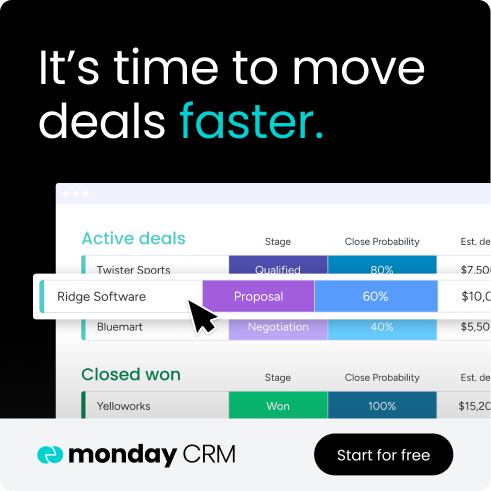A winning sales strategy gives your team clarity, focus, and momentum. It’s the blueprint that connects your product or service with the right customers, guiding every step from prospecting to sales closing. The most impactful strategies go beyond quotas and pipelines; they’re powered by AI insights, automation, and collaborative tools that help teams work smarter and scale faster.
In this guide, you’ll learn what a sales strategy is, how to create one step by step, and see real-world examples in action. We’ll also show you how monday CRM can bring your strategy to life with data-driven forecasting, AI-powered workflows, and customizable pipelines designed to fit your business.
Try monday CRMWhat is a sales strategy and why is it important?
A sales strategy is a detailed plan that includes actions, decisions, and goals for how your business will sell its products or services. It uniquely positions your company among its competitors, while also establishing sales processes, target audiences, product placement, and best practices.
Your business’s sales strategy serves as a roadmap for your sales team to follow, which ultimately helps improve overall performance and organizational growth. A well-thought-out sales strategy gives sales teams a clear direction and keeps every rep on the same page for consistent messaging and improved collaboration.
It also makes it easier for sales leaders to organize resources, whether it’s CRM software, sales material, or their workforce, based on priorities outlined in a sales strategy.
Inbound sales vs. outbound sales
When it comes to sales strategies, there are two main types: inbound sales and outbound sales. Sometimes, businesses can benefit more from one strategy over the other, and in some cases, businesses need a mix of both to thrive. Still, it’s important to consider which type of sales strategy to prioritize in your organization. Here’s how they differ:
Inbound sales strategy
Inbound sales focuses on attracting prospects to you rather than reaching out cold. It relies on personalized, value-driven marketing to capture attention and guide leads through the sales funnel.
Tactics: SEO, blogs, gated content, webinars, targeted ads
Benefit: Highly personalized and scalable
Challenge: Takes longer to build momentum
Outbound sales strategy
Outbound sales means proactively reaching out to prospects. Reps identify potential customers and initiate contact directly through channels like email, social media, or events.
Typical tactics: Cold emailing, cold calling, LinkedIn outreach, trade shows
Benefit: Faster path to new opportunities
Challenge: Can feel intrusive if not well-targeted
Considering 89% of business leaders find personalization invaluable to their business processes, it might sound like inbound sales is the superior strategy. In reality, the most effective sales strategies usually combine both approaches.
How to create a sales strategy in 6 steps
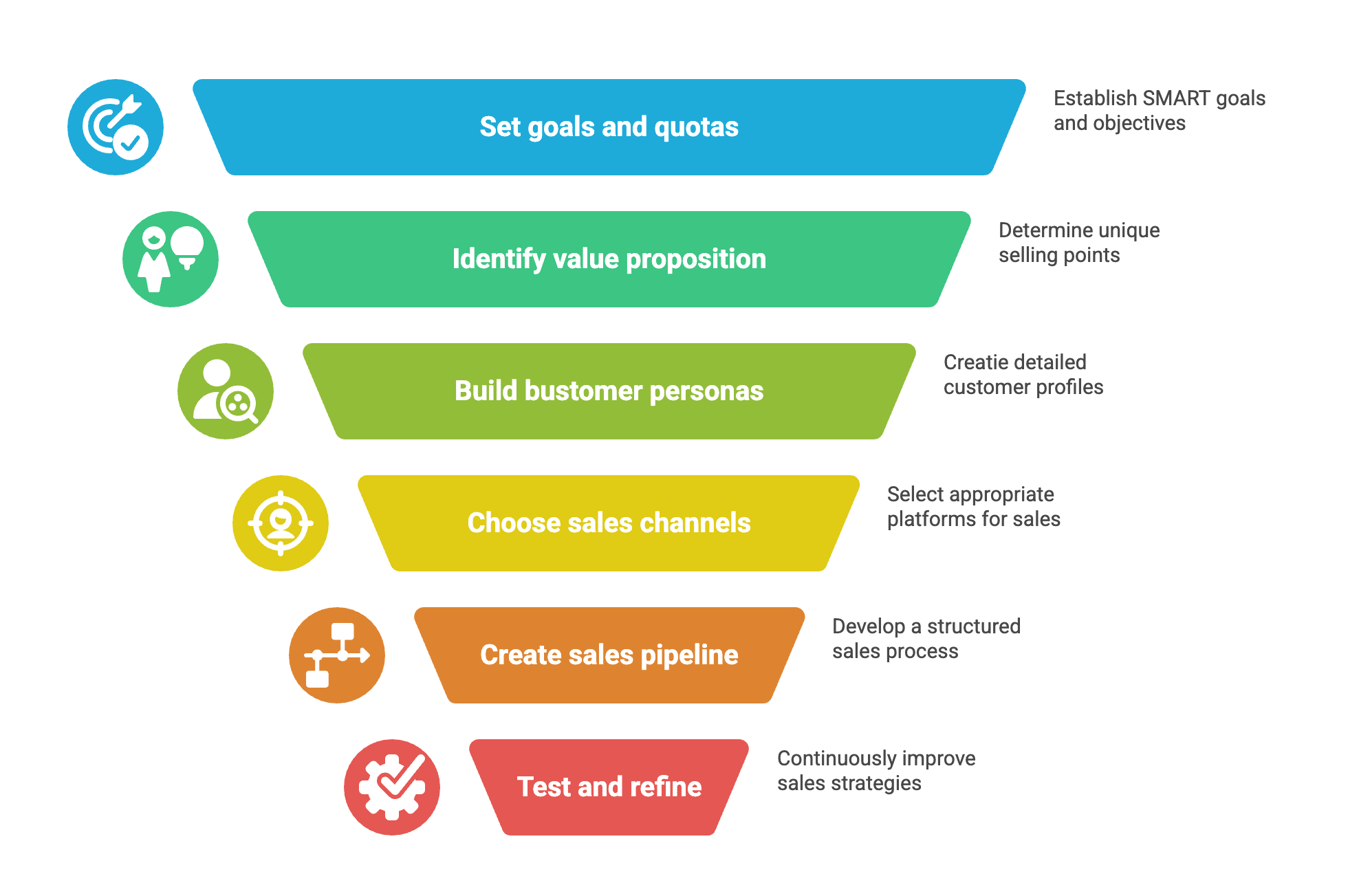
Before we dive into the specific steps in creating a sales strategy, it’s important to remember that your sales strategy needs to be tailored to your company’s unique audience, products, and value proposition. The steps we cover below provide a framework you can use to build your own custom sales strategy.
Step 1: Set sales goals and quotas
The first step is figuring out exactly what you want your sales strategy to achieve. This can manifest in a few different ways: sales targets, revenue goals, or growing your customer base.
Whatever your goal is, make sure it’s realistic and achievable. A good way to start is to brainstorm some SMART goals, which stands for specific, measurable, achievable, relevant, and time-bound. For example, a SMART goal may be hitting a $1 million sales target in 12 months.
Small business teams need to pay special attention to resource and budget constraints when setting goals. Small businesses should focus on incremental, achievable targets rather than aggressive growth goals that might overstretch teams. Start with modest revenue increases and build from there as your processes mature.
Aside from setting goals, in this stage, you should also take stock of what you’re already working with in terms of resources and manpower so you’re not overextending your team. This way, you can set reasonable quotas and deadlines that your team can reach.
Step 2: Identify your unique value proposition
Using your target marketing and competitor research, think about what truly sets you apart from the competition. Your unique value proposition is something that only you can offer a certain group of consumers and will be the cornerstone of your sales strategy. A unique value proposition allows you to tailor your sales strategy to exactly how your product benefits your specific audience.
A good starting point for building your unique value proposition is conducting a SWOT analysis to assess your team’s strengths, weaknesses, opportunities, and threats. This will help you understand where your team should focus its efforts and what risks might affect sales. You can also use a premade unique selling proposition template to get started quickly and work step by step.
Step 3: Build targeted customer personas
Once you’ve set your sales goals, it’s time to learn everything you can about both your ideal customer and your existing competitors. First, understand your target market’s demographics, then figure out their pain points. With this information, you can develop a buyer persona or ideal customer profile to use as a reference for future sales strategies.
Next, learn how your competitors are addressing these pain points, and see what you can offer that makes you a better choice than a competitor. Keep in mind that personalization is very important for many customers today, so another benefit of this research is to help you put your understanding of your audience’s needs into action. Leverage customer data into personalized campaigns, such as recommending products or tailored customer service experiences.
Step 4: Choose the right sales channels for your business
Once you have a customer persona, you should have a good idea of where your customers like to spend time, either online or in person. These should be your main sales channels. You want to get very specific here to narrow down exact platforms to focus on so that you can build targeted strategies for each.
For example, you may decide to sell on social media. However, there are tons of different social channels out there. If you’re in B2B sales, you’ll likely want to spend more time creating sales strategies for LinkedIn, whereas if you’re selling B2C, you can create your strategy around selling on Instagram or TikTok.
Step 5: Create a sales pipeline
Now that you know who you’re selling to and where, it’s time to start putting together a sales pipeline. This is a series of stages a prospect will go through before they become a customer. The exact stages and actions depend on whether you’re using inbound or outbound sales strategies, as well as whether you’re in B2C sales or B2B sales.
No matter which specific strategies you use, the sales pipeline stages often include prospecting, lead nurturing, a product demo or trial, and finalizing the sale. You can monitor your entire sales pipeline with lead tracking software or an all-encompassing solution like monday CRM.
Once you have this basic framework, you can use it to test different sales strategies. For instance, you might test sending follow-up emails at different intervals to see which has the best response rate, or you can test whether cold calling or cold emailing is more effective.
Step 6: Test and refine as needed
Consumer demands change, new competitors crop up, and sometimes strategies just get stale. That means your sales strategy will likely evolve and change over time. It’s important to check in regularly to see what’s working for your sales team and what’s not.
You can use dashboards and reports in a system like monday CRM to help you keep an eye on performance and stay aware of important sales insights. By regularly checking in and refining your process, you’ll be better positioned to handle unexpected changes.
Try monday CRMAligning sales and marketing for maximum impact
For B2B prospecting and inbound sales, it’s critical for sales and marketing teams to stay aligned on plans and strategies. Inbound sales strategies will largely involve the marketing team, who need to have a deep understanding of your customers to create personalized assets that will create high-value leads.
Without proper alignment, you risk creating disconnected customer experiences and longer sales cycles. So that your sales and marketing team collaborate seamlessly, consider implementing these strategies:
- Establish shared definitions: Agree on what constitutes a qualified lead and your ideal customer profile.
- Create unified buyer personas: Develop customer personas together so both teams target the same prospects.
- Hold regular check-ins: Schedule weekly meetings to share insights and discuss lead quality.
- Design integrated content: Create marketing materials that support each stage of the sales pipeline.
- Share performance data: Use centralized systems where both teams can access lead scoring and conversion rates.
- Develop consistent messaging: Ensure marketing campaigns and sales conversations use the same value propositions.
Sales strategy examples: 5 proven approaches
Different situations call for different approaches. The goal is to match your strategy to your customers’ buying behavior and your business’s objectives. These five sales strategies can be used across different sales teams, industry, and business sizes.
1. Consultative selling
In this approach, sales reps act as advisors, focusing on building trust and long-term relationships instead of pushing for a quick close. This approach works best in complex B2B sales where customers need guidance.
- Benefit: Builds loyalty and positions your team as trusted experts
- Challenge: Takes longer and requires deep product knowledge
- Example: IBM’s enterprise account managers often use a consultative approach to guide clients through multi-year digital transformation projects.
2. Value-based selling
Instead of competing on price, value-based selling has reps highlighting the tangible business value of a product or service. This strategy emphasizes ROI, outcomes, and problem-solving.
- Benefit: Effective for premium products and services
- Challenge: Requires strong proof points like case studies or ROI calculators
- Example: Apple positions its devices around design, performance, and ecosystem value rather than low prices.
3. SPIN selling
SPIN stands for situation, problem, implication, and need-payoff. With this approach, sales reps use structured questions to guide prospects toward recognizing their challenges and seeing your product as the solution.
- Benefit: Provides a repeatable framework for complex deals
- Challenge: Requires training and skill to avoid sounding scripted
- Example: Xerox, where SPIN originated, trained its sales teams to use this model to successfully close large-scale enterprise contracts.
4. Solution selling
In solution selling, reps position the product as the direct answer to a prospect’s specific business challenge, tailoring pitches to measurable outcomes.
- Benefit: Makes the offer highly relevant to each customer.
- Challenge: Demands deep discovery and research for every account.
- Example: Microsoft Cloud often uses solution selling by aligning its services with a company’s digital transformation goals.
5. Challenger selling
This methodology replicates the habits of top-performing reps. “Challengers” teach, tailor, and take control of the sales process, positioning themselves as subject-matter experts who drive the conversation.
- Benefit: Helps sales teams differentiate in competitive markets.
- Challenge: Can feel too aggressive if not executed with finesse.
- Example: Many SaaS companies influenced by Gartner’s Challenger Sale research use this method to win enterprise clients.
How to build a sales enablement strategy
Once you have your core sales strategy in place, it’s time to think about how you’ll equip your sales team with the tools, content, and knowledge they need to execute it successfully. Sales enablement is the process of providing your sales reps with everything they need to properly engage prospects and close deals.
A strong sales enablement strategy bridges the gap between your sales goals and your team’s ability to achieve them. It ensures that every rep has access to the right resources at the right time, whether that’s sales enablement software, product data, competitive intelligence, or messaging templates.
Here are a few effective sales enablement examples of tools and resources that can impact your team’s performance:
- Content libraries: Create a centralized repository where reps can quickly find case studies, product sheets, pricing guides, and presentation templates.
- Sales playbooks: Build step-by-step guides for different scenarios, such as how to handle objections, conduct discovery calls, or navigate complex buying processes.
- Training programs: Implement regular coaching sessions focused on product knowledge, industry trends, and sales techniques to keep your team sharp.
- CRM integration: Ensure your sales team has easy access to customer data, interaction history, and automated follow-ups to maintain consistent communication.
- AI and automation tools: Give your team access to advanced AI sales enablement software that can help with follow-ups, high-level insights, or sales asset generation.
The key is to keep your sales enablement resources updated and easily accessible. Ask your sales team for feedback regularly to learn what other resources can help them thrive so that you can fill in gaps with valuable tools.
4 real-world sales strategies examples
Looking at how recognizable companies use sales strategies to grow revenue and expand customer bases is a great way to start thinking of what to put into your own strategy. Here’s how two digital platforms, monday.com and Shopify, implemented sales strategies to corner their respective markets.
Shopify’s multi-market expansion strategy
Shopify shows how thinking globally can pay off. Instead of focusing on a single region, the company pursued multiple markets at once, fueling revenue growth across North America, Europe, and Asia Pacific. In Europe alone, Shopify’s sales volume jumped 42% year-over-year. Its platform works for everyone — from small businesses launching their first online store to enterprise brands like Supreme, ButcherBox, and Meta — which helped Shopify hit 31% overall revenue growth while keeping a healthy profit margin.
Amazon’s personalization-at-scale strategy
Amazon’s sales strategy revolves around personalization. Every interaction — from product recommendations to email offers — is powered by AI-driven algorithms and customer data. This creates a tailored shopping experience that keeps customers engaged and drives repeat purchases. Over the past decade, the success of this approach has resulted in 35% of Amazon’s sales coming from recommended products worth over $43 billion.
By turning personalization into a scalable inbound sales machine, Amazon set the standard for how data and automation can fuel long-term growth.
Tesla’s direct-to-consumer strategy
Tesla disrupted the traditional automotive model by bypassing dealerships and selling directly to customers. Its approach combines sleek showrooms for education with a seamless online buying experience, positioning sales reps as advisors rather than closers. By focusing on solution selling — showing how Tesla addresses performance, cost, and sustainability concerns — the company built loyalty and captured significant market share.
monday.com’s land-and-expand strategy
At monday.com, enterprise customers became the engine of growth through a classic land-and-expand strategy. Rather than chasing only new clients, monday.com focused on expanding within existing accounts, reaching a 112% net dollar retention rate. This approach, supported by a multi-product platform spanning work management, CRM, and dev tools, generated 46% year-over-year growth and revenue that outpaced competitors like Asana by more than $300M.
Execute a winning sales strategy with monday CRM
The best way to build a successful, data-based strategy and keep marketing and sales teams aligned is to adopt a platform to operate as a single source of truth for your organization. With a modern, AI-powered CRM, like monday CRM, your team can track every stage of your sales funnel and access insights that can impact meaningful change.
Backed by advanced AI capabilities, monday CRM helps teams streamline sales funnel activities. Sales and marketing teams can use the platform to gather insights on customer preferences, sales strategy effectiveness, and even team performance to stay on track with targets and business goals. The solution also offers an intuitive drag-and-drop interface that’s easy to use and quick to set up, making onboarding a simple affair.
Let’s take a more detailed look at some of monday CRM’s best features for sales strategy creation and execution.
Predictive analytics, sales forecasting, and insights
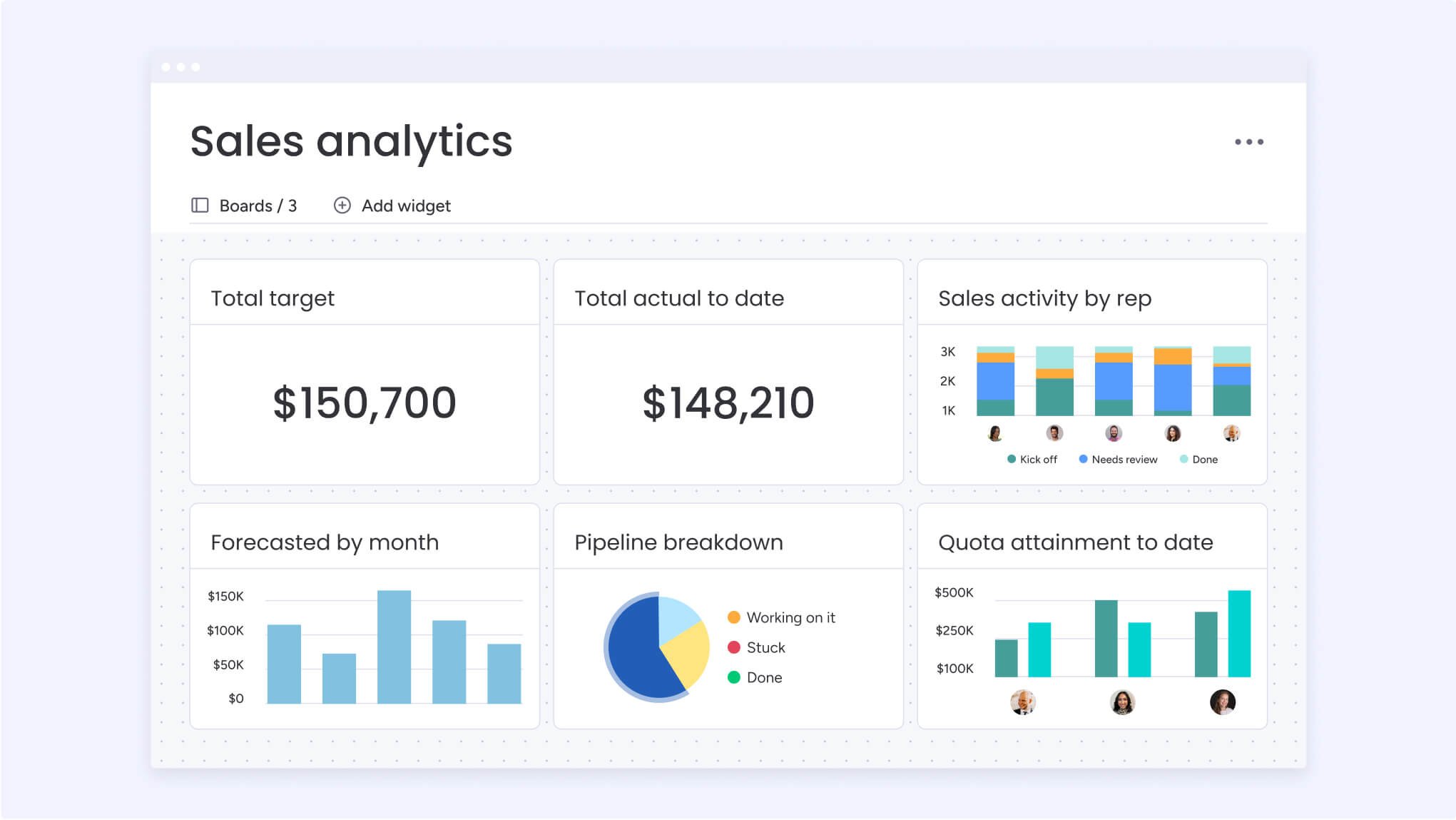
Anticipate future sales trends with predictive analytics and forecasts to get ahead of what customers want and identify potential roadblocks in your sales strategy before they turn into real issues. With monday CRM, you can analyze historical data, customer behavior patterns, and market trends to get accurate insights to inform essential decisions and understand what factors make a difference in your sales approaches.
AI-driven workflow automations
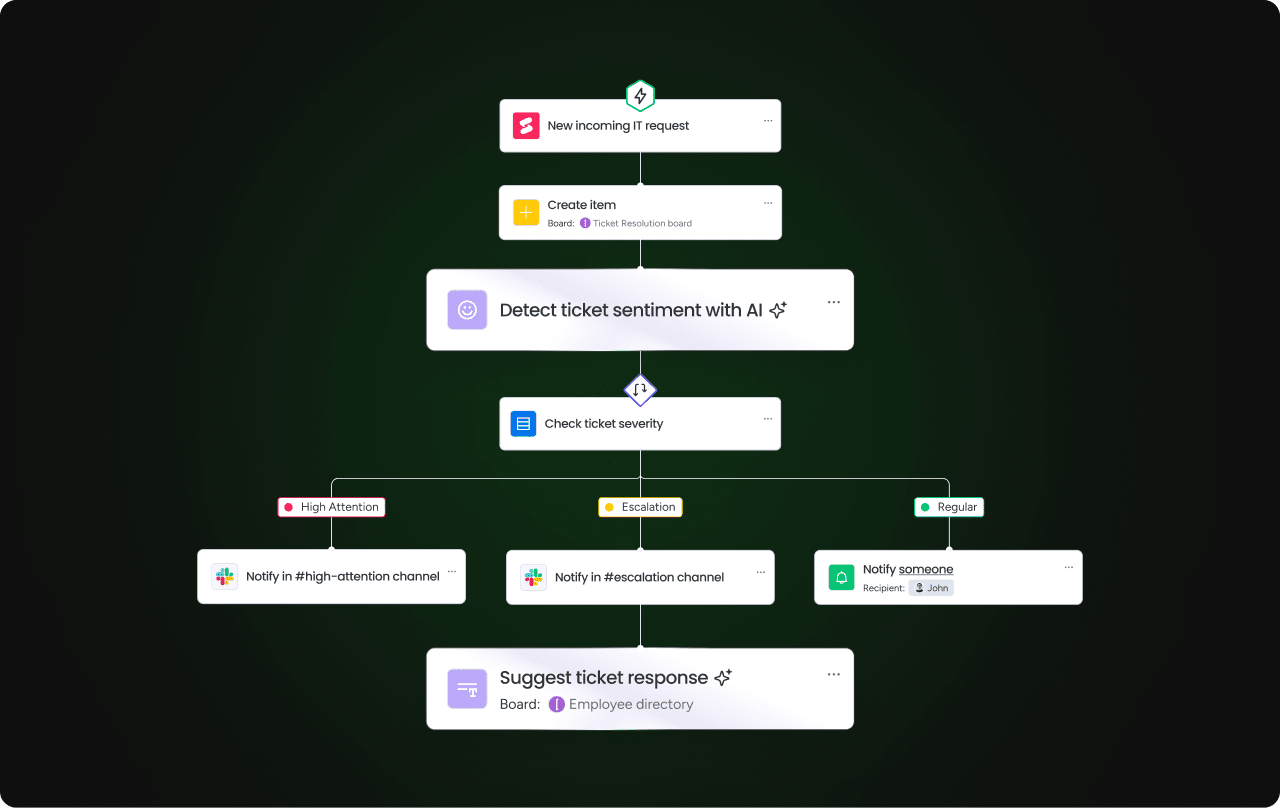
Streamline repetitive tasks and reduce manual work with smart CRM automations that use AI to adapt to your workflows. With monday CRM, teams can automatically assign new leads to the best team members, send personalized follow-up messages based on customer interactions, and update deal stages as prospects move through the pipeline.
Custom sales pipeline management
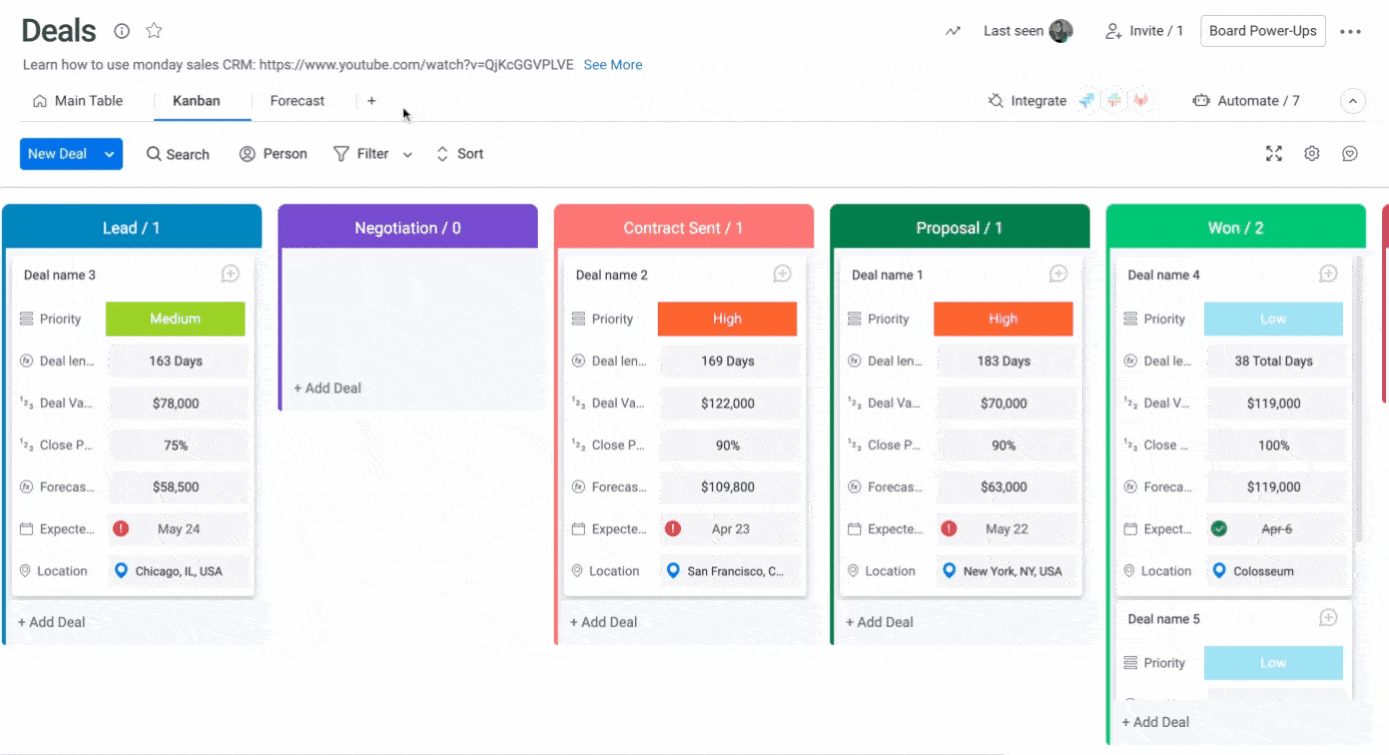
Build and customize your own sales pipeline that matches the sales strategy you created. The platform allows you to define unique customer stages, trigger approval processes, and track key B2C and B2B sales metrics at every stage of the buyer’s journey. With granular control over how you manage your pipeline, you can make sure you’re implementing your unique sales strategy down to the smallest details.
Templates for building a sales strategy
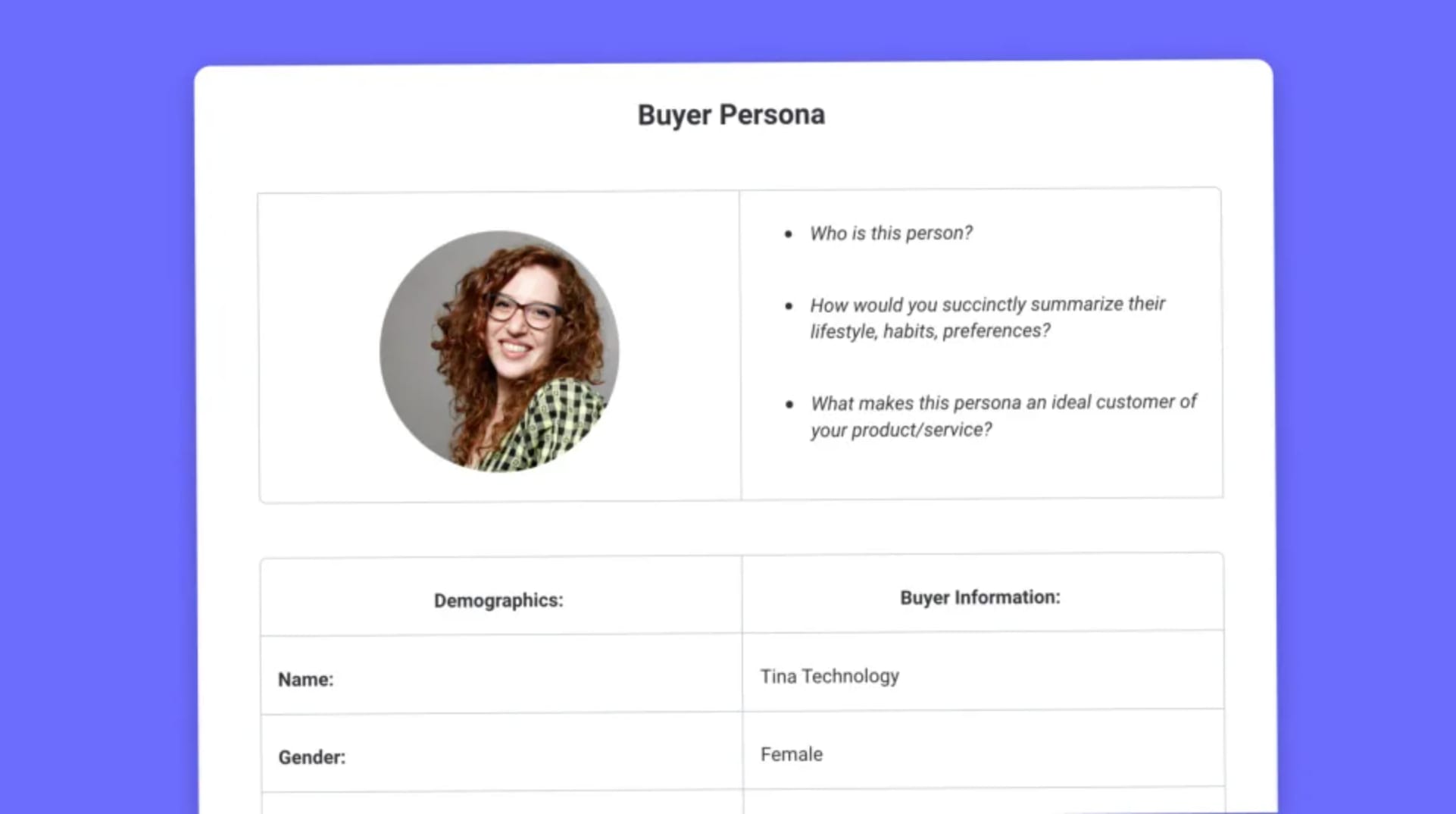
Get started quickly with pre-built templates that make different steps of building your sales strategy a lot smoother. For example, teams can use a SMART goal template to easily outline objectives without forgetting any information. There’s a buyer persona template to make it faster to gather important data about your audience. Teams can also use the sales plan template to set and work towards revenue goals.
Putting your sales strategy into action: Implementation and best practices
A well-crafted sales strategy without an implementation plan is like a car without tires. Even the most brilliant strategy risks falling apart without intentional execution and buy-in from your entire team. Here are a few best practices to consider when building an implementation plan for your sales strategy.
- Start small and expand your strategy: Begin by implementing your sales strategy with a pilot program or a specific product line before rolling it out company-wide to minimize risks and learn from early results.
- Evaluate and improve your sales strategy: Schedule monthly reviews to analyze key metrics, gather team feedback, and make data-driven adjustments to optimize your strategy’s effectiveness.
- Use sales strategy templates to speed up implementation: Leverage proven frameworks and templates for faster deployment and to make it easier for teams to collaborate and work cohesively from day one.
- Train your team thoroughly on new processes: Provide comprehensive training sessions and ongoing support to ensure every team member understands their role in executing the new sales strategy.
- Set clear accountability metrics and KPIs: Decide on specific sales metrics and KPIs to track to keep your sales team working towards the same goals and measure the success of your sales strategy.
- Document everything for consistency: Maintain detailed records of your processes, scripts, and sales procedures to facilitate consistent messaging and make it simpler to onboard new team members.
- Integrate technology tools gradually: Roll out new sales tools and platforms in phases so that you don’t overwhelm your team and leave enough time for proper adoption and training.
Start managing your sales strategy the right way
An effective sales strategy focuses your efforts and helps everyone, including sales managers, along with sales and marketing teams. A solid sales strategy can boost efficiency and productivity while creating a more personalized customer experience that increases satisfaction. Whether you’re focused on inbound or outbound, or B2B or B2C sales, a solution like monday CRM will make it easier to monitor, track, and improve every aspect of your sales strategy.
Try monday CRMFAQs
How do you create a sales strategy for a small business?
The best sales strategies for small businesses start with incremental, realistic goals — then grow with your budget and resources. Next, focus on one or two sales channels where your ideal customers spend time, create a straightforward buyer persona, and build a sales pipeline. The goal for small businesses is to keep their strategy simple and scalable. It’s easier to expand as your business grows than to start off with a heavier plan that’s challenging to execute.
What is a sales channel strategy?
A sales channel strategy defines where and how you sell — for example, through direct sales, partners, distributors, or online platforms. Choosing the right channels ensures you reach your target customers efficiently.
What are some examples of a successful sales growth strategy?
Some examples of successful sales growth strategies include account-based selling for B2B companies, referral programs that leverage satisfied customers, content marketing that attracts inbound leads, and strategic partnerships with complementary businesses. Many companies also experience growth through customer expansion strategies, where the focus is on upselling and cross-selling to existing clients rather than spending more resources acquiring new ones.
How do you measure the success of a sales strategy?
To measure how well your sales strategy is performing, track key metrics like conversion rates, average deal size, sales cycle length, and revenue growth compared to your baseline. It’s also important to monitor indicators such as qualified leads generated, pipeline velocity, and customer acquisition cost. Regular monthly metric reviews, along with team feedback sessions, will paint a picture of what’s working and what needs adjustment.
What is the difference between a sales strategy and a sales plan?
A sales strategy is a high-level approach that defines who you’re targeting, how you’ll position your product, and what channels you’ll use. A sales plan is a tactical execution document that breaks down specific activities, timelines, quotas, and responsibilities. A sales strategy addresses the “what and why” of selling, while a sales plan gets into more details on “how and when.”
How can a sales strategy benefit a company?
A clear sales strategy aligns your entire team around common goals and messaging, leading to more consistent customer experiences and higher conversion rates. It helps you effectively allocate resources, identify the most high-value opportunities, and stay agile to market changes. Plus, it provides a framework for measuring performance and making data-driven improvements to your sales process.
How can AI improve a sales strategy?
AI can surface insights from customer data, predict buying behavior, and automate repetitive tasks. Tools like monday CRM use AI to forecast sales, personalize outreach, and streamline workflows, helping teams sell smarter.
 Get started
Get started 


